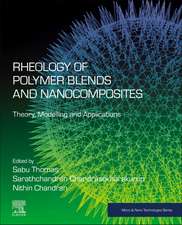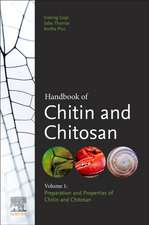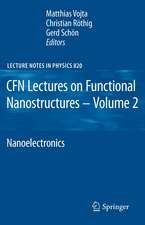Handbook of Magnetic Hybrid Nanoalloys and their Nanocomposites: Handbook of Magnetic Hybrid Nanoalloys and their Nanocomposites
Editat de Sabu Thomas, Amirsadegh Rezazadeh Nochehdehien Limba Engleză Hardback – 28 oct 2022
Part 1 covers theory, modelling, and synthesis (growth and alloying mechanisms) of MHNAs. Formation mechanisms of magneto-electric multiferroic materials, magnetic carbon nanotube (CNTs), and perovskite materials, which are a novel class of next-generation multifunctional nanomaterials, are discussed. The second part focuses on characterization techniques for electrical and dielectrical, rheological, biocompatibility, and other properties, as well as applications in the industrial, agricultural, environmental, and biomedical sectors. Finally, life cycle assessment is considered as essential to the development of nanomaterials and nanoproducts from MHNAs. Advanced undergraduate and graduate students, researchers, and other professionals in the fields of materials science and engineering, polymer science, surface science, bioengineering, and chemical engineering will find comprehensive and authoritative information for solving fundamental and applied problems in the characterization and use of these multifunctional nanomaterials.
Preț: 4218.92 lei
Preț vechi: 5145.03 lei
-18% Nou
Puncte Express: 6328
Preț estimativ în valută:
807.67€ • 842.72$ • 677.04£
807.67€ • 842.72$ • 677.04£
Carte disponibilă
Livrare economică 19 februarie-05 martie
Preluare comenzi: 021 569.72.76
Specificații
ISBN-13: 9783030909475
ISBN-10: 3030909476
Pagini: 1274
Ilustrații: XXVII, 1274 p. 432 illus., 364 illus. in color. In 2 volumes, not available separately.
Dimensiuni: 155 x 235 mm
Greutate: 2.81 kg
Ediția:1st ed. 2022
Editura: Springer International Publishing
Colecția Springer
Seria Handbook of Magnetic Hybrid Nanoalloys and their Nanocomposites
Locul publicării:Cham, Switzerland
ISBN-10: 3030909476
Pagini: 1274
Ilustrații: XXVII, 1274 p. 432 illus., 364 illus. in color. In 2 volumes, not available separately.
Dimensiuni: 155 x 235 mm
Greutate: 2.81 kg
Ediția:1st ed. 2022
Editura: Springer International Publishing
Colecția Springer
Seria Handbook of Magnetic Hybrid Nanoalloys and their Nanocomposites
Locul publicării:Cham, Switzerland
Cuprins
Part I: Theory, Modeling and Synthesis. Chapter 1: Introduction to nanotechnology and nano-alloys.- Chapter 2: Introduction to nanomedicine; nanotechnology in medicine.- Chapter 3: Introduction to magnetic materials and their properties.- Chapter 4: Iron and iron oxide magnetic nanoparticles (IOMNs).- Chapter 5: Synthesis of cobalt and its metallic magnetic nanoparticles (CMNs & CBMNs).- Chapter 6: Synthesis of iron-based magnetic nanocomposites (IBMNs).- Chapter 7: Synthesis of cobalt-based magnetic nanocomposites (CMNs & CBMNs).- Chapter 8: Synthesis of iron-cobalt nanoalloys (ICNAs) and their metallic composites.- Chapter 9: Synthesis of core-shell magnetic nanoparticles (CS-MNs).- Chapter 10: Synthesis of magnetoelectric multiferroic materials and their composites.- Chapter 11: Synthesis of magnetic carbon nanotubes and their composites.- Chapter 12: Manufacturing techniques of magnetic polymer nanocomposites.- Chapter 13: Vacuum based deposition techniques to synthesize magnetoelectric multiferroic materials.- Chapter 14: Theory, modeling, and simulation of magnetic hybrid nanoalloys.- Part II: Characterization techniques and applications. Chapter 15: Microscopy techniques.- Chapter 16: X-ray scattering techniques (XST).- Chapter 17: Neutron scattering techniques (NST).- Chapter 18: Light scattering techniques (LST).- Chapter 19: Vibrating sample magnetometry (VSM).- Chapter 20: Spectroscopic techniques.- Chapter 21: Rheological characterization.- Chapter 22: XPS, SIMS, and nanoSIMS.- Chapter 23: Thermal analysis.- Chapter 24: Contact angle studies.- Chapter 25: Electrical and dielectric characterization.- Chapter 26: Ageing studies.- Chapter 27: Diffusion and transport studies.- Chapter 28: Biological characterization.- Chapter 29: Industrial applications of magnetic alloy nanoparticles and their polymer nanocomposites.- Chapter 30: Agricultural applications of magnetic alloy nanoparticles and their polymer nanocomposites.- Chapter 31: Environmental applications of magnetic alloy nanoparticles and their polymer nanocomposites.- Chapter 32: Medicinal and biological application of magnetic alloy nanoparticles and their polymer nanocomposites.- Chapter 33: Life cycle analysis of specified magnetic alloy nanoparticles.
Notă biografică
Professor Sabu Thomas is currently Vice Chancellor of Mahatma Gandhi University. He is also a full professor of Polymer Science and Engineering at the School of Chemical Sciences of Mahatma Gandhi University, Kottayam, Kerala, India and the Founder Director and Professor of the International and Interuniversity Centre for Nanoscience and Nanotechnology. Prof. Thomas is an outstanding leader with sustained international acclaims for his work in Nanoscience, Polymer Science and Engineering, Polymer Nanocomposites, Elastomers, Polymer Blends, Interpenetrating Polymer Networks, Polymer Membranes, Green Composites and Nanocomposites, Nanomedicine and Green Nanotechnology. Dr. Thomas’ ground breaking inventions in polymer nanocomposites, polymer blends, green bionanotechnological and nano-biomedical sciences, have made transformative differences in the development of new materials for automotive, space, housing and biomedical fields. In collaboration with India’s premier tire company, Apollo Tires, Professor Thomas’s group invented new high performance barrier rubber nanocomposite membranes for inner tubes and inner liners for tires. Professor Thomas has received a number of national and international awards which include: Fellowship of the Royal Society of Chemistry, London FRSC, Distinguished Professorship from Josef Stefan Institute, Slovenia, MRSI medal, Nano Tech Medal, CRSI medal, Distinguished Faculty Award, Dr. APJ Abdul Kalam Award for Scientific Excellence – 2016, Mahatma Gandhi University- Award for Outstanding Contribution –Nov. 2016, Lifetime Achievement Award of the Malaysian Polymer Group, Indian Nano Biologists award 2017 and SukumarMaithy Award for the best polymer researcher in the country. He is in the list of most productive researchers in India and holds a position of No.5. Because of the outstanding contributions to the field of Nanoscience and Polymer Science and Engineering, Prof. Thomas has been conferred Honoris Causa (D.Sc) Doctorate by the University of South Brittany, Lorient, France and University of Lorraine, Nancy, France. Very recently, Prof. Thomas has been awarded Senior Fulbright Fellowship to visit 20 Universities in the US and most productive faculty award in the domain Materials Sciences. Very recently he was also awarded with National Education Leadership Award – 2017 for Excellence in Education. Prof. Thomas also won 6th contest of "mega-grants" in the grant competition of the Government of the Russian Federation (Ministry of Education and Science of the Russian Federation) designed to support research projects implemented under the supervision of the world’s leading scientists. He has been honored with Faculty Research Award of India’s brightest minds in the field of academic research in May 2018. Professor Thomas was awarded with Trila – Academician of The Yearin June 2018 acknowledging his contribution to tire industry. In 2019 Professor Thomas has been selected as a member of Prestigious European Academy of Sciences. Professor Thomas has published over 800 peer reviewed research papers, reviews and book chapters. He has co-edited 127 books published by Royal Society, Wiley, Wood head, Elsevier, CRC Press, Springer, and Nova etc. He is the inventor of 15 patents. The H index of Prof. Thomas is 97 and has more than 44,339 citations. Prof. Thomas has delivered over 350 Plenary/Inaugural and Invited lectures in national/international meetings over 30 countries.
Amirsadegh Rezazadeh Nochehdehi is currently an academic staff at University of South Africa (UNISA). An experienced, detail-oriented and accelerated Executive Metallurgist and Materials Engineering Technologist (ECSA Accelerated), Biomedical Science and Engineer with demonstrated history of working over 10 years in research and development, quality management system (control and assurance), safety engineering and inspection, urban and suburban railway transportation systems, wind and solar renewable energy.He is also PhD fellow at theUNISA Biomedical Engineering Research Group (UBERG), Department of Mechanical Engineering (DME), University of South Africa (UNISA), and Johannesburg, South Africa. Furthermore, he graduated from Materials and Biomaterials Research Center, Iran (MSc) with a degree in Biomedical Engineering – Division of Biomaterials in 2017. He also graduated from Karaj Branch of Islamic Azad University, Iran (BSc) with a degree in Materials and Metallurgy Engineering – division of Industrial Metallurgy in 2012. As a research scholar, He has worked in polymer nanocomposites for tissue regeneration applications at International and Inter-University Center for Nano-science and Nano-technology (IIUCNN) in Mahatma Gandhi University (MGU), Kerala, India, in 2018. He also worked in magneto-metallic alloy nanoparticles at Nanotechnology Research Center at University of Zululand, South Africa as visiting research in 2017. He is distinguished scientific researcher (R&D projects) in the field of metallurgy and materials design, metal casting and solidification, steel alloying, ferrous and non-ferrous metals, materials specifications, advanced materials, hydrogen storage materials, nanoscience and nanotechnology, materials and nanomaterial fabrication, nanomedicine, nanomaterials, nanocomposites, magnetic nanoparticles, magnetic nano-alloys, magnetic hyperthermia, nanomaterial in cancer diagnosis and treatment, biomedical science and engineering, bio-materials, 3D printing biomaterials biomechanics, mechanics of tissue, soft tissue biomechanics,mechanical modeling, cartilage mechanics and joint preservation, and regenerative medicine.
Amirsadegh Rezazadeh Nochehdehi is currently an academic staff at University of South Africa (UNISA). An experienced, detail-oriented and accelerated Executive Metallurgist and Materials Engineering Technologist (ECSA Accelerated), Biomedical Science and Engineer with demonstrated history of working over 10 years in research and development, quality management system (control and assurance), safety engineering and inspection, urban and suburban railway transportation systems, wind and solar renewable energy.He is also PhD fellow at theUNISA Biomedical Engineering Research Group (UBERG), Department of Mechanical Engineering (DME), University of South Africa (UNISA), and Johannesburg, South Africa. Furthermore, he graduated from Materials and Biomaterials Research Center, Iran (MSc) with a degree in Biomedical Engineering – Division of Biomaterials in 2017. He also graduated from Karaj Branch of Islamic Azad University, Iran (BSc) with a degree in Materials and Metallurgy Engineering – division of Industrial Metallurgy in 2012. As a research scholar, He has worked in polymer nanocomposites for tissue regeneration applications at International and Inter-University Center for Nano-science and Nano-technology (IIUCNN) in Mahatma Gandhi University (MGU), Kerala, India, in 2018. He also worked in magneto-metallic alloy nanoparticles at Nanotechnology Research Center at University of Zululand, South Africa as visiting research in 2017. He is distinguished scientific researcher (R&D projects) in the field of metallurgy and materials design, metal casting and solidification, steel alloying, ferrous and non-ferrous metals, materials specifications, advanced materials, hydrogen storage materials, nanoscience and nanotechnology, materials and nanomaterial fabrication, nanomedicine, nanomaterials, nanocomposites, magnetic nanoparticles, magnetic nano-alloys, magnetic hyperthermia, nanomaterial in cancer diagnosis and treatment, biomedical science and engineering, bio-materials, 3D printing biomaterials biomechanics, mechanics of tissue, soft tissue biomechanics,mechanical modeling, cartilage mechanics and joint preservation, and regenerative medicine.
Textul de pe ultima copertă
Caracteristici
Presents comprehensive synthesis information including sol-gel, vapor deposition, and atom beam sputtering Explores varied industrial, agricultural, environmental, and biomedical applications Includes chapters by international experts in each area























